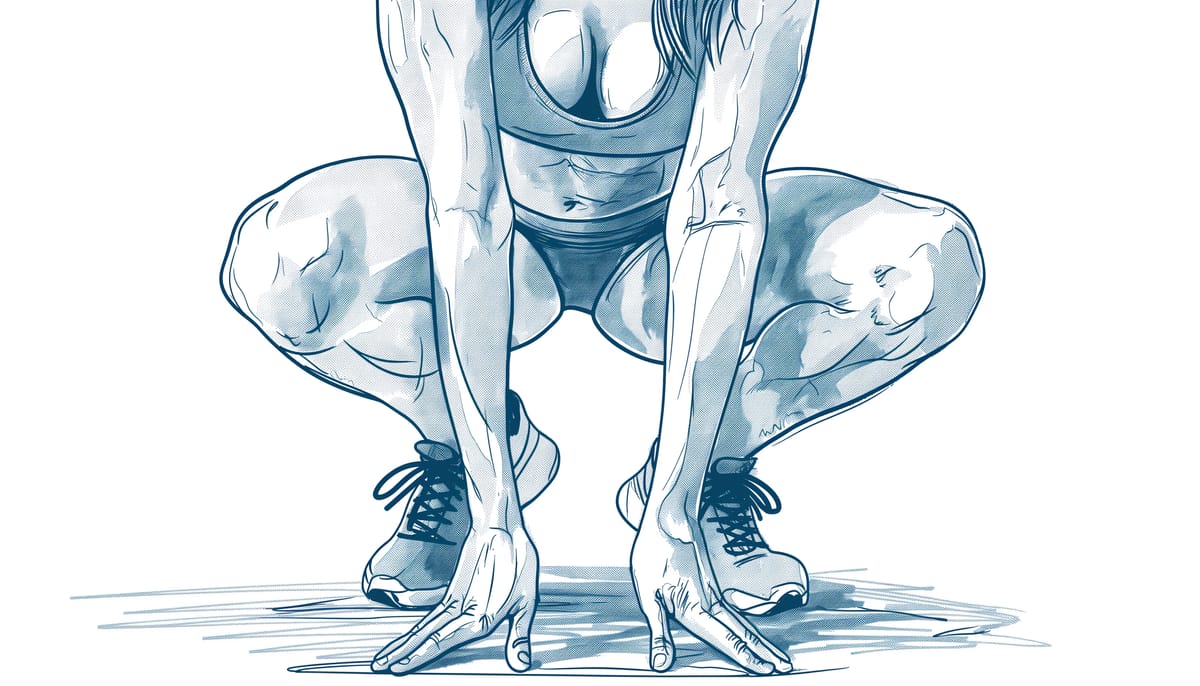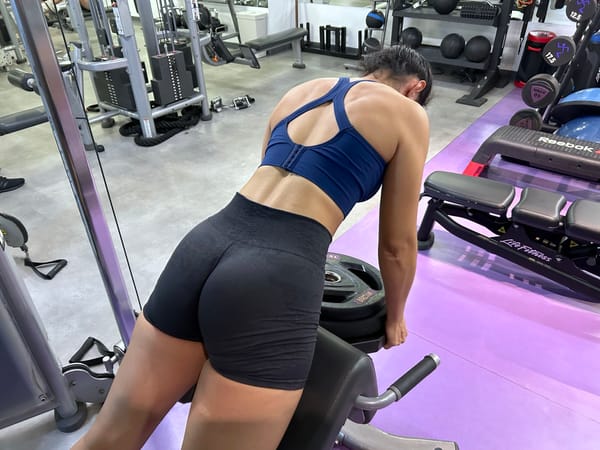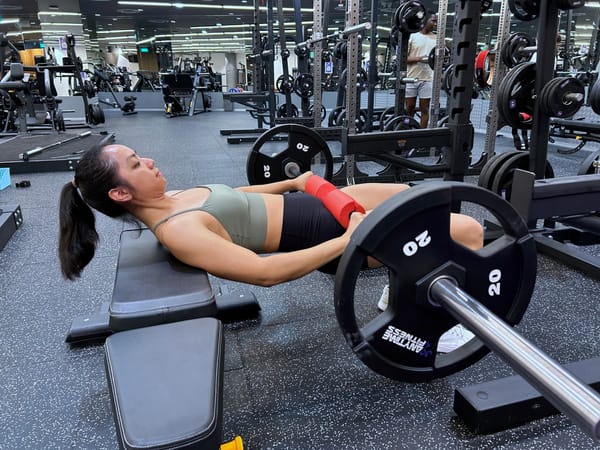How to Get Bigger Quads (Science-Based Exercises and Tips)
Outer sweeps. Teardrops. Juicy massive quads. If that's got you drooling, be glad you found this article. Because here's how to get bigger quads.

Well-developed quads — complete with outer sweeps and teardrops 💧— are what dreams are made of. *cue Hilary Duff*
But the actual process of getting them? It can be a nightmare. Especially when you’ve been doing endless sets of barbell back squats, and all you’ve been rewarded with are shaky steps up and down the stairs.
Quads growth = sadly, nothing you can see.
Well, this article’s about to change all that.
Because when it comes to how to get bigger quads, there’s so much more you need to do than just barbell back squats.
To understand why, we’ll have to start from the beginning: what are quad muscles?
What are quad muscles?
Quad muscles are muscles found at the front of your thigh. Uh, wait a minute. Muscles?
Yes, contrary to popular belief, your quads aren’t just 1 big muscle group.
Instead, your quad muscles anatomy consists of 4 individual muscles:
- 3 vastus muscles: They include the vastus lateralis (outer sweep), vastus medialis (teardrop muscle), and vastus intermedius (located under the rectus femoris in the mid-thigh; not visible). These are all uni-articular muscles that cross only your knee joint. They help with knee extension, which is straightening your legs from a bent position, and kneecap stabilization.
- Rectus femoris (mid-thigh): The only biarticular quad muscle that crosses both your hip and knee joints. As a result, the rectus femoris helps with knee extension and hip flexion, where your knees come toward the chest.
How to get bigger quads
OK, now that you know the anatomy of your quad muscles, here’s a question we must tackle right away.
Are squats good enough to get bigger quads?
See, the barbell back squat (or any squat movement, really) involves both hip extension and knee extension at the same time.
Simultaneous hip extension and knee extension pull on the rectus femoris in opposite directions — keeping the muscle relatively inactive throughout. This prevents the rectus femoris from contracting fully during the squat.
Meaning?
You won’t be working your rectus femoris hard enough if you were to only do barbell back squats.
And, FYI, of all your quad muscles, the rectus femoris is the most superficial (located closest to the skin), so even a tiny bit of growth will likely be visible.
But before naming the specific quad exercises that’ll actually grow your rectus femoris, it’s important to note that your 3 vastus muscles would likely also appreciate some variety.
Case in point: a 2014 study published in the Journal of Strength and Conditioning Research.
The researchers compared quadriceps’ growth between the following 2 groups:
- Participants evenly divided their training volume between lunges, deadlifts, leg presses, and Smith machine squats
- Participants performed all their training volume with Smith machine squats
Guess what the researchers found after 12 weeks? While both groups reported similar overall quad muscle growth, only the participants in the “varied group” had significant growth in all quadriceps heads.
Alright.
So, with all that said, here are the 2 points you need to take away for how to get bigger quads:
Exercises for bigger quads
Now, without further ado, here’s the list of quad exercises that’ll help you get that mid-thigh bulk (from your rectus femoris and vastus intermedius), plus those sweeps and teardrops.
#1: Barbell back squat
Equipment needed: Barbell and a squat rack
Preferentially targets: Vastus muscles
Yes, the barbell back squat doesn’t target your rectus femoris, but it’s still great for your vastus muscles. That said, it can be an exceptionally challenging exercise to get right, especially if you’re new to strength training.
So here are a few tips on how to get bigger quads with the barbell back squat:
Choose a high bar squat or a low bar squat based on preference and mobility. With the high bar squat, your barbell rests just above your shoulders. With the low bar squat, the barbell rests further down on your back (across the shoulder blades). Each of them has their own mobility requirements, so find out which you can do better — and just focus on doing that well.
This creates the stiffness needed for your torso to remain stable throughout each rep — allowing for an efficient transfer of force. To brace your core correctly, think about expanding your stomach “outwards in all directions”. Just as you would do if someone was about to punch you in your stomach.
Make sure each foot maintains 3 solid points of contact — 1) big toe, 2) pinky toe, and 3) heel — with the ground at all times. This ensures an efficient force transfer and prevents you from tipping (forward or backward) when you perform the barbell back squat.
“Ass to grass” looks great … but only if you have the mobility to do so safely. Signs that you’re overly optimistic about your mobility? Rounding of your lower back at the bottom position, heels coming off the floor, and/or torso tipping forward.
Don’t use momentum to “cheat” the movement, especially when you’re coming out of the bottom position. Thinking about bouncing out of your squat like some people do in the gym? Yes, it can be done safely and effectively, especially if you have years of training experience and a strong foundation. For most trainees, however, don’t overthink it — and just focus on doing the basics really well.
Take a breath (and brace hard) before you start the rep. On the way up from your squat, exhale gradually after you’ve passed the halfway mark. The Valsalva maneuver likely isn’t something you need to be too concerned with early on. It’s more commonly used with near-maximal loads (or reps) you’d encounter at an advanced stage. Once again, don’t overthink it!
Note that there are many barbell back squat alternatives out there. E.g., barbell front squat, Smith machine squat, hack squat, pendulum squat, you get the point.
You’re free to choose the squat variant that you like the most and would be most likely to stay consistent with.
To perform the barbell back squat:
#2: Leg press
Equipment needed: Leg press machine
Preferentially targets: Vastus muscles
A lot of things need to go right for you to perform the barbell back squat well. E.g., (just the tip of the iceberg) adequate shoulder, mid-torso, and ankle mobility.
So, if you’re new to the gym and are still working your way to the needed mobility — and comfort level — to meaningfully and safely target your quads with the barbell back squats, try the leg press.
There are literally fewer moving parts you need to care about.
Plus, sometimes, the leg press machine can really come in handy during rush hour in the gym. You know, when your chances of sighting a free squat rack become as slim as winning the lottery 🤷♀️.
Here are a few tips on how to get bigger quads with the leg press:
Positioning your feet slightly lower on the platform increases the degree of knee flexion and extension while reducing the degree of hip extension and flexion. This means you get more quad activation and less involvement from the glutes and hamstrings. (Note: less doesn’t mean 0; muscle activation is all a matter of degree.)
Yes, you shouldn’t skimp out on your range of motion. But you also shouldn’t chase depth at the expense of form. Go as far down as far as you can while ensuring that your back stays flush with the pad. If your lower back rounds or shifts, you’re exceeding your range
Keep your feet around hip-width apart (you may need to play around with your feet width to see what’s most comfortable for you) and watch your knees as you lower the weight. Make sure they don’t cave in, especially when you’re pushing up.
While there’s no research suggesting that locking out puts your knees at a higher risk of injury, it’s generally sound advice to avoid hyperextension under heavy loads. After all, we all know how carried away we can get when we’re pushing the weight up with everything we have.
To perform the leg press:
#3: Front-foot elevated split squats
Equipment needed: Dumbbells and a step-up board
Preferentially targets: Vastus muscles
Painful as they may be, the front-foot elevated splits squats definitely belong to the list of “must-mention” quad exercises when it comes to how to get bigger quads. For 2 reasons:
- May prevent muscle imbalances: It’s a unilateral exercise, which means you work 1 leg at a time.
- May improve ankle mobility: Elevating the front foot allows your knee to move forward more (at the bottom position). This helps you work on your ankle dorsiflexion (basically curling your toes towards your shin) — improving your ankle mobility over time. A lack of ankle mobility could affect your performance on exercises such as the back squat and step-ups.
Here are a few tips on how to get bigger quads with the front-foot elevated split squat:
Thinking about pushing your knees past your toes while keeping the weight evenly distributed across your whole foot.
Helps your knee move forward more, letting you achieve greater depth. What’s going on here is a greater amount of knee extension.
Think about your back foot simply as a stabilizer. It shouldn’t be taking most of the load off your front foot.
Pushing straight up keeps your load on the front foot. Pushing backwards shifts the load to your back foot and could make it harder to stay balanced.
To perform the front-foot elevated split squat:
#4: Leg extension
Equipment needed: Leg extension machine
Preferentially targets: Rectus femoris
So far, none of the quads exercises we’ve mentioned target the rectus femoris (which is the most superficial quads muscle and, thus, key if you’d like bigger quads 🔑).
But that changes with the leg extension.
By holding your hip flexion constant (at approximately 80 to 90 degrees), the leg extension lets you focus on knee flexion. Unlike in a back squat — where your rectus femoris remains relatively inactive — the leg extension allows you to contract them fully.
Here are a few tips on how to get bigger quads with the leg extension:
Adjust the backrest such that you’re able to lean back slightly, so you have more than 90 degrees of hip flexion. Compared to sitting upright, this lets you contract your rectus femoris more effectively. The larger hip angle reduces the contraction of the rectus femoris at the hip joint, allowing it to contract harder at the knee.
This anchors your body firmly to the seat for an efficient transfer of force — and honestly, keeps you from flying out of your seat. The heavier you go, the more important this gets.
Pointing slightly inwards could activate your vastus lateralis (outer sweeps) a little more. For other quad muscles, there are no significant differences in foot position. So, point straight ahead by default — or simply go with whatever feels best for you.
To perform the leg extension:
#5: Reverse Nordic curl
Equipment needed: None
Preferentially targets: Rectus femoris
Looking for more ways to hit your rectus femoris? Then try the reverse Nordic curl.
Similar to the leg extension, your hip angle remains relatively constant throughout the movement, and this allows you to optimally target the (often) neglected in your quad muscles anatomy: the rectus femoris.
“OK, but which should I pick if I can only do 1?”
Um, I’m not trying to mess with you, but you should include both quad exercises (i.e., leg extension and reverse Nordic curl) in your workout routine if possible.
That’s because they offer different resistance profiles.
The leg extension offers the most resistance when your quads are fully contracted, while the reverse Nordic curl offers the most resistance when your quads are fully lengthened. And … why’s that important?
Because research says, your muscles love variety — and tend to show optimal hypertrophy when exposed to different types of exercises with different resistance profiles.
But if you had to pick 1? Then I’d say go with the 1 you prefer and are more likely to perform consistently.
Here are a few tips on how to get bigger quads with the reverse Nordic curl:
Stability is key here. Keep the same hip angle throughout — so you can work the rectus femoris more effectively with contractions from the knee joint. Think of a straight line running from your knees up through your shoulder. You want to maintain that line as much as possible.
Avoid going too deep, too fast. If needed, set a bench or box behind you to limit your depth and to provide feedback. Pay close attention to the stretch you feel in your quads to avoid overdoing it.
This is not an exercise you want to rush through. Focus on feeling the stretch at the bottom position and avoid using momentum to bounce back.
To perform the reverse Nordic curl:
Creating a workout with those quad exercises
Great. Now that you’re armed with a list of the best quad exercises out there, do you just … smush them together and perform them all in a single session at the gym?
No. Please don’t.
For most people, layering the front foot elevated split squat and leg press on top of barbell back squats is overkill.
Instead, we’d suggest picking 3 to 4 exercises from this list while including at least 1 rectus-femoris-focused exercise.
Here’s an example of exercises you can incorporate into your training:
#1: Barbell back squat (3 sets, 6 to 8 reps)
#2: Front-foot elevated split squat (3 sets, 8 to 10 reps per leg)
#3: Leg extension (3 sets, 10 to 12 reps)
#4: Reverse Nordic curl (3 sets, 12 to 15 reps)
As with all your muscle groups, train your quads at least 2 to 3 times weekly for optimal growth.
What else to know about how to get bigger quads
When it comes to how to get bigger quads, it’s not just what you do inside the gym that’s important — more specifically, beyond training with the appropriate mix of quads exercises, intensity, and frequency, you should ideally also:
- Eat at a calorie surplus
- Hit your daily protein intake (strive for 1.6 grams of protein per kg of body weight)
- Recover well; because recovery is when your body builds muscle
- Be patient and consistent (muscle-building takes time!)
Alright. That’s all I have on how to get bigger quads.
If you found this valuable, then you’d probably like this article on how to get a bigger butt, too.





